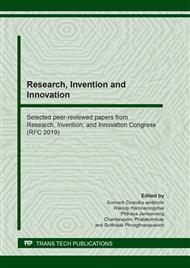p.230
p.237
p.245
p.253
p.261
p.268
p.276
p.286
p.294
Eco-Friendly Composites Derived from Natural Rubber and Wasted Materials
Abstract:
The fillers from agriculture and industrial wastes filled natural rubber (NR) have been prepared to clarify their properties and develop to be the eco-friendly composites. This research aims to study the composites namely rice husk ash (RHA)/NR, clay/NR and crumb rubber/NR composites on the curing characteristics, mechanical and morphological properties. The results indicated that depending on a chemical composition of fillers, the properties of the composites are varied. For clay/NR composite, the occurrence of vulcanization was delayed comparing to the others. In term of mechanical properties, crumb/NR composite shows a toughest characteristic, for examples, it has the highest tensile strength, elongation at break and tear resistance, whereas hysteresis loss was found to be lowest among the composites. The toughness of crumb/NR composite can be influenced by a better interfacial interaction between filler and matrix comparing to the others as revealed by SEM. The clay/NR composite, on the other hand, has the highest hardness among the composites due to the hardness of clay itself and its uniformity of particle size. In the case of RHA/NR composite, from morphological observation by SEM shows that RHA particles have very poor dispersion in NR matrix which resulted in poor mechanical properties. However, the presence of RHA agglomerates was found to be beneficial for loading a high stress under a small deformation, for example, at 25% elongation. Therefore, these three difference composites from wasted materials were found to have unique characteristics which can be chosen and applied for some specific applications.
Info:
Periodical:
Pages:
261-267
Citation:
Online since:
August 2020
Keywords:
Price:
Сopyright:
© 2020 Trans Tech Publications Ltd. All Rights Reserved
Share:
Citation:


